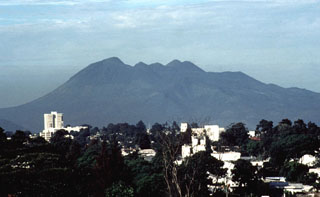Report on Pacaya (Guatemala) — 7 August-13 August 2013
Smithsonian Institution / US Geological Survey
Weekly Volcanic Activity Report, 7 August-13 August 2013
Managing Editor: Sally Sennert.
Please cite this report as:
Global Volcanism Program, 2013. Report on Pacaya (Guatemala) (Sennert, S, ed.). Weekly Volcanic Activity Report, 7 August-13 August 2013. Smithsonian Institution and US Geological Survey.
Pacaya
Guatemala
14.382°N, 90.601°W; summit elev. 2569 m
All times are local (unless otherwise noted)
INSIVUMEH reported that during 7-8 August white vapor plumes rose 200 m above Pacaya and drifted E. On 9 August seismicity increased, and Strombolian explosions ejected tephra 200 m above MacKenney Crater and onto the flanks, 400 m away from crater. The next day the number and magnitudes of explosions increased, and seismic signals indicating fluid movement were recorded. Tephra was again ejected 400 m away from MacKenney Crater, causing small avalanches of volcanic material on the flanks. On 12 August fumarolic plumes rose 50 m. Cloud cover prevented observations of the crater on 13 August; however, the seismic network recorded a few gas explosions and tremor.
Geological Summary. Eruptions from Pacaya are frequently visible from Guatemala City, the nation's capital. This complex basaltic volcano was constructed just outside the southern topographic rim of the 14 x 16 km Pleistocene Amatitlán caldera. A cluster of dacitic lava domes occupies the southern caldera floor. The post-caldera Pacaya massif includes the older Pacaya Viejo and Cerro Grande stratovolcanoes and the currently active Mackenney stratovolcano. Collapse of Pacaya Viejo between 600 and 1,500 years ago produced a debris-avalanche deposit that extends 25 km onto the Pacific coastal plain and left an arcuate scarp inside which the modern Pacaya volcano (Mackenney cone) grew. The NW-flank Cerro Chino crater was last active in the 19th century. During the past several decades, activity has consisted of frequent Strombolian eruptions with intermittent lava flow extrusion that has partially filled in the caldera moat and covered the flanks of Mackenney cone, punctuated by occasional larger explosive eruptions that partially destroy the summit.
Source: Instituto Nacional de Sismologia, Vulcanologia, Meteorologia, e Hidrologia (INSIVUMEH)

